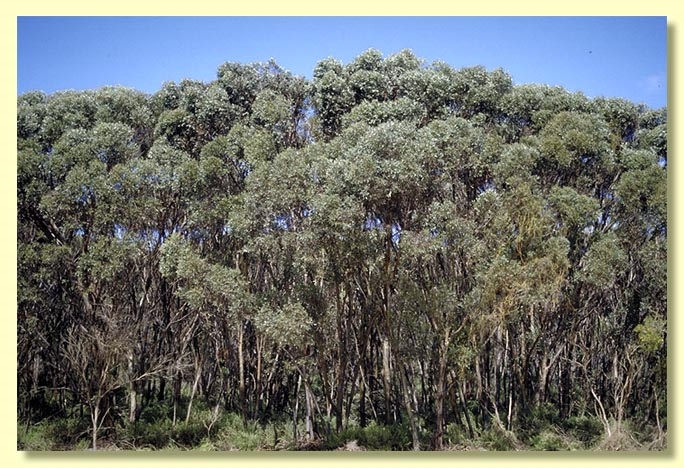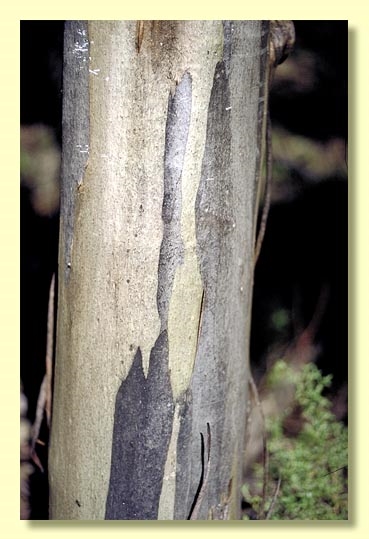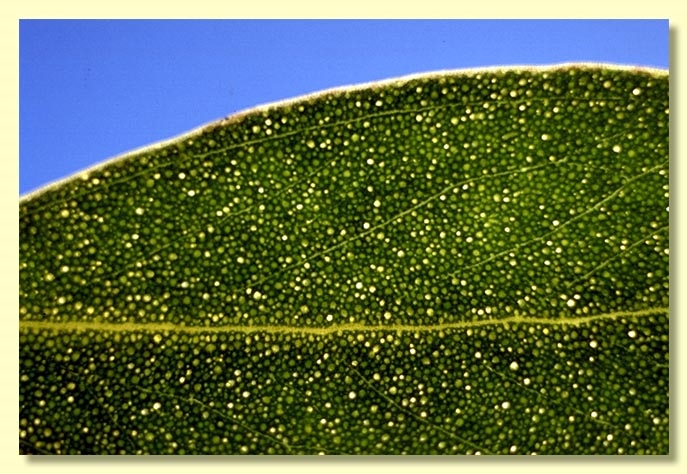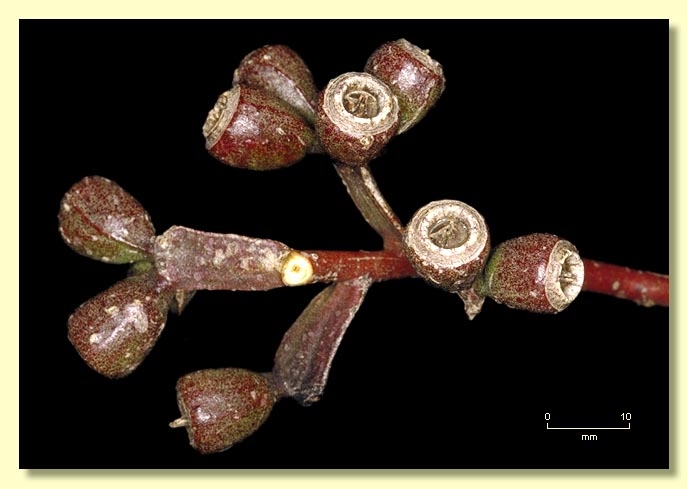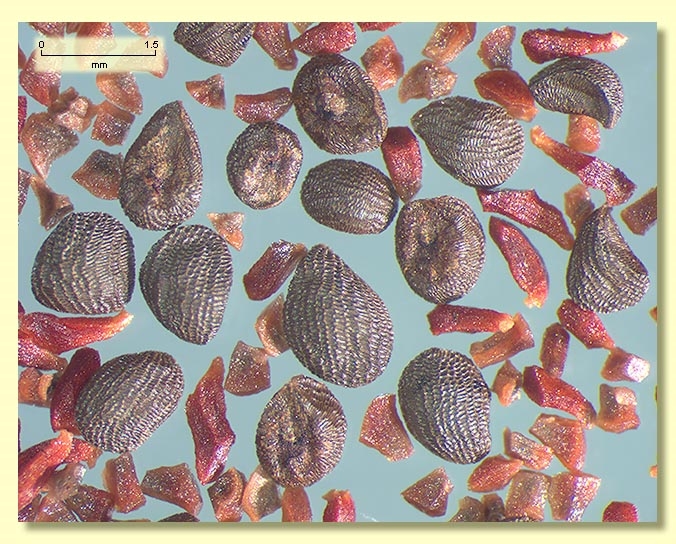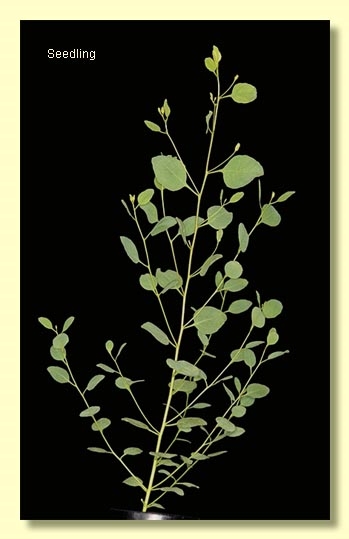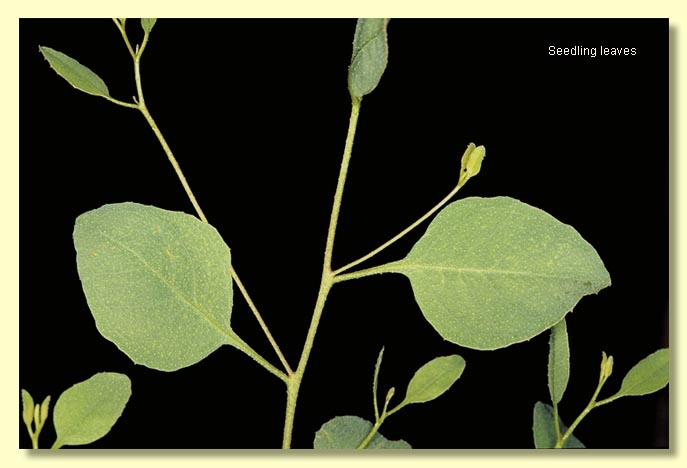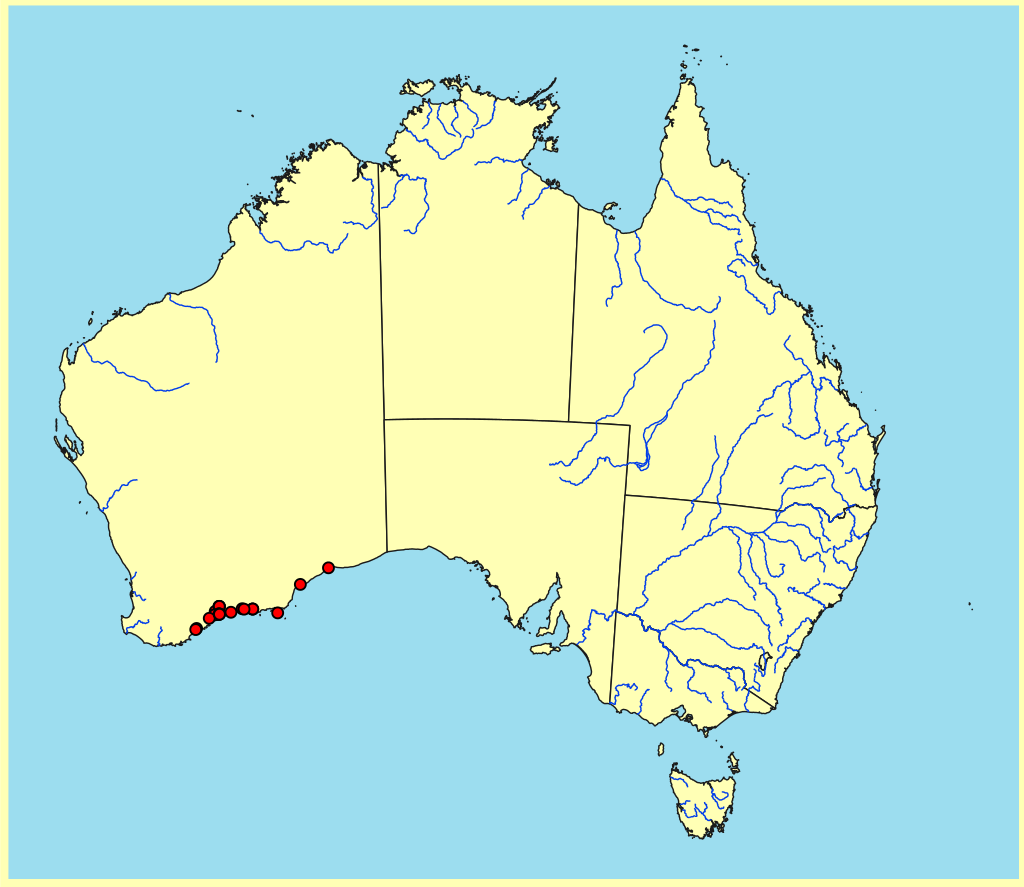Eucalyptus | Symphyomyrtus | Bisectae | Glandulosae | Erectae | Abundae
Euclid - Online edition
Eucalyptus utilis
T: Hopetoun, 19 Oct. 1964, C.A.Gardner 14888; holo: PERTH.
Eucalyptus platypus var. heterophylla Blakely, Key Eucalypts 107 (1934). Type: near Ongerup, Western Australia, 30 May 1917, F. Stoward s.n.; holo: NSW. = E. platypus Hook. X E. spathulata Hook. (fide S.D.Hopper).
Bark smooth throughout, grey to grey-green over coppery to orange.
Branchlets have oil glands in the pith.
Juvenile growth (coppice or field seedlings to 50 cm): stems rounded in cross-section, may feel rough on lower parts; juvenile leaves always petiolate, alternate, ovate, 2–8 cm long, 1.5–3.5 cm wide, green to grey-green, lowest leaves may feel rough.
Adult leaves alternate, thick, held erect, petioles 0.8–2 cm long; blade ovate to lanceolate, rarely almost elliptical, 4.5–8 cm long, 1–3(4) cm wide, base tapering to petiole, margin entire or indented, apex pointed, concolorous, green, glossy, surface appearing "glazed", side-veins acute or obscure, reticulation not visible, intramarginal vein remote from margin, oil glands numerous, round or slightly irregular.
Inflorescence axillary unbranched, peduncles broadly flattened, erect to slightly spreading in bud and flower stage, 1.3–3.3 cm long; buds 7 per umbel, shortly pedicellate or sessile (pedicels 0–0.5 cm long). Mature buds elongated ovoid, 1.2–2.8 cm long, 0.4–0.7 cm wide, with the hypanthium wider than the operculum at the join, scar present (outer operculum lost early), inner operculum horn-shaped, sometimes slightly warty, ca 1.2–2.3 times the length of the ribbed hypanthium, stamens erect, in about 3 whorls on the broad staminophore, anthers oblong, versatile, dorsifixed, dehiscing by longitudinal slits, style long and straight, stigma blunt to slightly dilated, locules 3 or 4, the placentae each with 4 vertical rows of ovules. Flowers creamy white.
Fruit on down-turned to spreading peduncles, sessile or shortly pedicellate (pedicels 0–0.6 cm long, obconical or less commonly almost barrel-shaped, 0.8–1.3 cm long, 0.7–1 cm wide, staminophore conspicuous, disc descending, valves 3 or 4, held at rim level or with fragile tips scarcely exserted.
Seeds blackish brown, 0.7–2 mm long, ovoid to flattened-ovoid, dorsal surface shallowly and clearly reticulate, hilum ventral.
Cultivated seedlings (measured at node 10): cotyledons Y-shaped (bisected); stems rounded in cross-section, scabrid or warty throughout; leaves always petiolate, opposite for 2 to 6 nodes then alternate, deltoid to ovate, 2–5 cm long, 1.5–3.5 cm wide, green to grey-green, scabrid on both surfaces until at least node 15.
Flowering has been recorded in January and December.
Eucalyptus utilis is very common and popular in cultivation in southern Australia and has long been erroneously referred to as E. platypus var. heterophylla, the type specimen of which from near Ongerup has been shown to be a hybrid between E. platypus and E. spathulata. Eucalyptus utilis is widely planted as a street tree and also as a windbreak on farms.
A mallet or bushy marlock endemic to Western Australia, of coastal distribution from east of Albany to Esperance, Cape Arid, some islands of Recherche Archipelago, and sporadically north-east to Twilight Cove–Baxter Cliffs area; particularly in dunes. The bark is smooth and the adult leaves glazed olive green, buds clusters are borne on spreading broadly flattened peduncles and the buds have an elongated operculum.
Eucalyptus utilis is distinguished fromboth subspecies of E. platypus by having narrower, more lanceolate adult leaves, not elliptical to orbicular, bud clusters on erect to spreading, not down-turned, peduncles and coastal sand-dune habitat, not flats with heavy soil. E. utilis like E. platypus and E. nutans lacks a lignotuber. Eucalyptus nutans has similar habit, adult leaves and erect staminal arrangement to E. utilis but differs in having buds with a much shorter operculum, red/pink flowers and fruit with 5(6) valves. Eucalyptus cernua and E. vesiculosa differ from E. utilis in having consistently inflexed, not erect, stamens in bud, prominently down-turned bud clusters and short rounded opercula, not long horn-shaped.
Operculum length relative to hypanthium
Flower colour
Fruit width cm
Adult leaf shape
nutans
operculum = hypanthium
red or pink-red
1.4–1.9
elliptic, oblong, suborbicular
platypus (both subspp.)
operculum 1.5–3 times hypanthium
pale yellow-green, rarely red
0.8–1.3
elliptic to orbicular
utilis
1.2–2.3 times hypanthium
creamy white
0.7–1.0
ovate to lanceolate
In the classification of Brooker (2000) Eucalyptus utilis belongs in Eucalyptus subgenus Symphyomyrtus section Bisectae subsection Glandulosae because the buds have an operculum scar, cotyledons are bisected and branchlets have oil glands in the pith. Within this very large subsection, E. utiltis is closely related to E. platypus and E. nutans, having similar general habit, four-angled buds in clusters of seven on conspicuous broadly flattened and sometimes long peduncles, erect stamens, and highly glandular leaves with obscure venation and indented margins.

